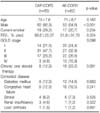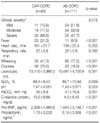1. Torres A, Dorca J, Zalacaín R, Bello S, El-Ebiary M, Molinos L, et al. Community-acquired pneumonia in chronic obstructive pulmonary disease: a Spanish multicenter study. Am J Respir Crit Care Med. 1996. 154:1456–1461.
2. American Thoracic Society. Standards for the diagnosis and care of patients with chronic obstructive pulmonary disease. Am J Respir Crit Care Med. 1995. 152:S77–121.
3. Global strategy for the diagnosis, management and prevention of chronic obstructive pulmonary disease [Internet]. Global Initiative for Chronic Obstructive Lung Disease (GOLD). c2009. cited 2009 Nov 18. place unknown: GOLD;Available from:
http://www.goldcopd.org.
4. Lieberman D, Gelfer Y, Varshavsky R, Dvoskin B, Leinonen M, Friedman MG. Pneumonic vs nonpneumonic acute exacerbations of COPD. Chest. 2002. 122:1264–1270.
5. Garcia-Vidal C, Carratalà J, Fernández-Sabé N, Dorca J, Verdaguer R, Manresa F, et al. Aetiology of, and risk factors for, recurrent community-acquired pneumonia. Clin Microbiol Infect. 2009. 15:1033–1038.
6. Anthonisen NR, Manfreda J, Warren CP, Hershfield ES, Harding GK, Nelson NA. Antibiotic therapy in exacerbations of chronic obstructive pulmonary disease. Ann Intern Med. 1987. 106:196–204.
7. Yoo SJ, Oh HJ, Shin BM. Evaluation of four commercial IgG- and IgM-specific enzyme immunoassays for detecting Mycoplasma pneumoniae antibody: comparison with particle agglutination assay. J Korean Med Sci. 2007. 22:795–801.
8. Grayston JT, Aldous MB, Easton A, Wang SP, Kuo CC, Campbell LA, et al. Evidence that Chlamydia pneumoniae causes pneumonia and bronchitis. J Infect Dis. 1993. 168:1231–1235.
9. Molinos L, Clemente MG, Miranda B, Alvarez C, del Busto B, Cocina BR, et al. Community-acquired pneumonia in patients with and without chronic obstructive pulmonary disease. J Infect. 2009. 58:417–424.
10. Siddiqi A, Sethi S. Optimizing antibiotic selection in treating COPD exacerbations. Int J Chron Obstruct Pulmon Dis. 2008. 3:31–44.
11. Roche N, Rabbat A, Zureik M, Huchon G. Chronic obstructive pulmonary disease exacerbations in emergency departments: predictors of outcome. Curr Opin Pulm Med. 2010. 16:112–117.
12. Mandell LA, Wunderink RG, Anzueto A, Bartlett JG, Campbell GD, Dean NC, et al. Infectious Diseases Society of America/American Thoracic Society consensus guidelines on the management of community-acquired pneumonia in adults. Clin Infect Dis. 2007. 44:Suppl 2. S27–S72.
13. Pifarre R, Falguera M, Vicente-de-Vera C, Nogues A. Characteristics of community-acquired pneumonia in patients with chronic obstructive pulmonary disease. Respir Med. 2007. 101:2139–2144.
14. Restrepo MI, Mortensen EM, Pugh JA, Anzueto A. COPD is associated with increased mortality in patients with community-acquired pneumonia. Eur Respir J. 2006. 28:346–351.
15. Ko FW, Ip M, Chan PK, Ng SS, Chau SS, Hui DS. A one-year prospective study of infectious etiology in patients hospitalized with acute exacerbations of COPD and concomitant pneumonia. Respir Med. 2008. 102:1109–1116.
16. Piquet J, Maurer C, Barbieux H, Chavaillon JM, Debieuvre D, Lebas FX, et al. Acute exacerbations of COPD admitted to hospital: predictive factors of 3 year mortality. Rev Mal Respir. 2007. 24:909–916.
17. Sethi S, Murphy TF. Infection in the pathogenesis and course of chronic obstructive pulmonary disease. N Engl J Med. 2008. 359:2355–2365.
18. Sethi S, Evans N, Grant BJ, Murphy TF. New strains of bacteria and exacerbations of chronic obstructive pulmonary disease. N Engl J Med. 2002. 347:465–471.
19. Murphy TF, Brauer AL, Eschberger K, Lobbins P, Grove L, Cai X, et al. Pseudomonas aeruginosa in chronic obstructive pulmonary disease. Am J Respir Crit Care Med. 2008. 177:853–860.
20. Ko FW, Ip M, Chan PK, Fok JP, Chan MC, Ngai JC, et al. A 1-year prospective study of the infectious etiology in patients hospitalized with acute exacerbations of COPD. Chest. 2007. 131:44–52.
21. Joo SK, Koo SW, Kim MA, Cho YH, Cha ST, Hong GY, et al. Bacterial etiology in hospitalized patients with acute exacerbations of chronic obstructive pulmonary disease. Korean J Med. 2009. 77:309–314.
22. Fang GD, Fine M, Orloff J, Arisumi D, Yu VL, Kapoor W, et al. New and emerging etiologies for community-acquired pneumonia with implications for therapy: a prospective multicenter study of 359 cases. Medicine (Baltimore). 1990. 69:307–316.
23. Snijders D, van der Eerden M, de Graaff C, Boersma W. The influence of COPD on mortality and severity scoring in community-acquired pneumonia. Respiration. 2010. 79:46–53.
24. Roche N, Zureik M, Soussan D, Neukirch F, Perrotin D. Predictors of outcomes in COPD exacerbation cases presenting to the emergency department. Eur Respir J. 2008. 32:953–961.
25. Confalonieri M, Urbino R, Potena A, Piattella M, Parigi P, Puccio G, et al. Hydrocortisone infusion for severe community-acquired pneumonia: a preliminary randomized study. Am J Respir Crit Care Med. 2005. 171:242–248.
26. Torres A, Menéndez R. Mortality in COPD patients with community-acquired pneumonia: who is the third partner? Eur Respir J. 2006. 28:262–263.
27. Snijders D, Daniels JM, de Graaff CS, van der Werf TS, Boersma WG. Efficacy of corticosteroids in community-acquired pneumonia: a randomized double-blinded clinical trial. Am J Respir Crit Care Med. 2010. 181:975–982.
28. García-Vázquez E, Marcos MA, Mensa J, de Roux A, Puig J, Font C, et al. Assessment of the usefulness of sputum culture for diagnosis of community-acquired pneumonia using the PORT predictive scoring system. Arch Intern Med. 2004. 164:1807–1811.
29. Bartlett JG. Diagnosis of bacterial infections of the lung. Clin Chest Med. 1987. 8:119–134.







 PDF
PDF ePub
ePub Citation
Citation Print
Print




 XML Download
XML Download